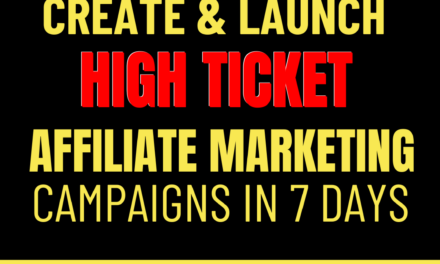1. Introduction To High
The world of digital sales is expansive and dynamic, offering myriad opportunities for savvy
entrepreneurs. Within this landscape, high-ticket digital sales have emerged as a critical arena for
businesses aiming to maximize their revenue and build sustainable, profitable ventures. In this
introduction, we’ll delve into the concept of high-ticket products, highlight the importance of selling
these items digitally, and explore the myriad benefits of high-ticket sales for digital entrepreneurs.
High-ticket products are items or services with a significantly higher price point compared to
standard offerings. These products typically include exclusive services, premium courses, advanced
software packages, or comprehensive consultancy sessions. High-ticket items require a higher level
of investment from the buyer, both financially and in terms of decision-making.
- Exclusive Services: These are personalized or custom solutions that cater to specific client
needs. - Premium Courses: High-value educational materials that offer specialized knowledge or
skills. - Advanced Software Packages: Comprehensive solutions that provide extensive features and
benefits. - Consultancy Sessions: In-depth professional guidance from experts in a field.
Understanding high-ticket products entails recognizing their value proposition. These products often
solve complex problems, cater to niche markets, or provide substantial value and results.
Consequently, they command a premium price, appealing to customers looking for quality and
willing to invest in superior solutions
Importance of Selling High-Ticket Items Digitally
In the digital age, selling high-ticket items online is not just a trend but a strategic imperative for
many businesses. The digital landscape breaks geographical barriers, reaching a global audience
with minimal overhead costs. Here are some compelling reasons why it is crucial:
1. Expansive Reach: The internet provides access to a broad, international clientele, allowing
businesses to tap into markets that were previously inaccessible.
2. Scalability: Digital platforms enable businesses to scale rapidly, accommodating growth
without the limitations of physical space or local market saturation.
3. Cost-Efficiency: Selling online reduces the need for physical storefronts, reducing costs
associated with rent and utilities.
4. Data-Driven Insights: Digital tools offer valuable analytics that can inform sales strategies,
helping businesses understand customer behavior and preferences.
By selling high-ticket items digitally, businesses can leverage technology to optimize sales
processes, personalize customer experiences, and foster long-term client relationships, enhancing
their market position substantially
Benefits of High-Ticket Sales for Digital Entrepreneurs
High-ticket sales offer numerous advantages to digital entrepreneurs, driving growth and sustainability. These benefits include:
- Increased Revenue: Selling high-ticket items significantly boosts revenue due to the higher
price points, even with a smaller volume of sales. - Enhanced Brand Image: Offering premium products positions the brand as a leader in its
niche, attracting a discerning clientele and enhancing brand prestige. - Customer Loyalty: High-ticket customers often seek long-term solutions and relationships,
leading to increased brand loyalty and repeat business. - Market Differentiation: By entering the high-ticket domain, businesses differentiate
themselves from competitors, establishing a unique value proposition that sets them apart.
Furthermore, high-ticket sales allow entrepreneurs to focus on quality over quantity, honing in on
core competencies and delivering exceptional service. This approach often results in more meaningful and profitable business relationships.
In conclusion, high-ticket digital sales represent a promising opportunity for entrepreneurs looking to achieve substantial growth and market leadership. By understanding the concept of high-ticket products, the importance of digital sales, and the benefits they offer, digital entrepreneurs can effectively harness this strategy to propel their businesses to new heights.

2. Identifying and Understanding Your Target Audience
Identifying and Understanding Your Target Audience
In the dynamic world of digital marketing, understanding your target audience is pivotal to any
successful marketing strategy. A well-defined audience is the cornerstone of efficient
communication, ensuring your message resonates effectively.
1. Conducting Comprehensive Market Research
The first step in identifying your target audience is thorough market research. This
process involves gathering, analyzing, and interpreting information about your market,
product, competitors, and potential audience. Comprehensive market research not only
highlights who your customers are but also reveals their preferences and behaviors. This
strategic insight is crucial for creating tailored marketing campaigns that deliver results.
Primary Research
Conduct surveys, interviews, and focus groups to gather firsthand insights directly
from consumers. This direct interaction provides a deeper understanding of
consumer attitudes, buying preferences, and specific needs.
Secondary Research
Analyze existing data such as industry reports, competitor analysis, and trends
publications. Secondary research helps in understanding the broader market
landscape and identifying potential gaps that your business could fill.
2. Creating Detailed Buyer Personas
Creating detailed buyer personas involves crafting fictional, yet realistic representations
of your ideal customers. These personas provide clarity on the demographics,
motivations, challenges, and purchasing behaviors of your target audience.
Demographic Details: Age, gender, income, occupation, and education level are crucial demographics to
consider when creating buyer personas. These details help shape targeted marketing messages and product offerings that appeal to specific audience sectors.
Behavioral Insights: Understanding how your audience interacts with products or services provides valuable insights. Consider their purchasing frequency, preferred communication channels, and decision-making processes. Behavioral insights are critical for developing personalized engagement strategies.
Psychographic Factors: Delve into the lifestyle, values, interests, and opinions of your potential customers. Psychographic factors help in crafting emotionally resonant marketing messages that align with your audience’s personal beliefs and attitudes.
3. Analyzing Customer Pain Points and Needs: Understanding and addressing customer pain points is vital to delivering value and
enhancing customer satisfaction. Analyze the challenges and needs that your audience experiences to offer solutions that directly address these issues.
Identify Pain Points: Identify specific problems, challenges, or frustrations that your customers face. Use customer feedback, product reviews, and social media to gather information about their pain points.
Addressing Unmet Needs: Determine the unmet needs of your audience and how your product or service can
fulfill them. Aligning your offerings to meet these needs not only attracts but alsoretains customers, fostering long-term loyalty.
Tailoring Solutions: Develop tailored solutions that address identified pain points. This involves adjusting your products, services, or marketing strategies to best serve the unique needs of your audience, thereby enhancing user experience and satisfaction.

3. Crafting a High
Outline 3: Crafting a High-Value Offer
Building a high-value offer is essential for businesses that aim to succeed in a competitive marketplace. A high-value offer attracts discerning customers who are willing to pay a premium for products or services that effectively meet their needs. This segment discusses crafting compelling value propositions, designing premium product features and benefits, and structuring pricing strategies for high-ticket items.
Developing a Compelling Value Proposition
A compelling value proposition clearly communicates the unique benefits a product or service offers. It differentiates your offering from competitors and resonates with the target audience. Crafting a standout value proposition involves several key steps:
1. Identify Your Target Audience: Understanding your target audience is crucial. Analyze their demographics, preferences, pain points, and purchasing behaviors to align your offer with their needs.
2. Highlight Unique Benefits: Clearly articulate what sets your product or service apart. Focus on the unique benefits
it provides, emphasizing why these attributes are valuable to your target audience.
3. Use Clear and Persuasive Language: Craft a message that is not only clear and concise but also engaging. Persuasive
language underlines credibility and value, compelling potential customers to take action.
Designing Premium Product Features and Benefits
Premium products demand premium features and benefits. Such enhancements justify higher prices and appeal to consumers seeking quality and exclusivity. Consider the following when designing premium product features:
1. Innovation and Quality: Develop products with cutting-edge features and superior quality. Innovative designs and high-quality materials enhance consumer perception and add value.
2. Customer Experience: Enhance the customer experience by offering premium support, superior packaging, or exclusive membership perks. These elements contribute to a unique and memorable customer journey.
3. Emotional Connection : Strive to create an emotional connection between the product and consumers. Tell a story that resonates, tapping into values and lifestyle aspirations
Structuring Pricing Strategies for High-Ticket Items
Premium products demand premium features and benefits. Such enhancements justify higher prices and appeal to consumers seeking quality and exclusivity. Consider the following when designing premium product features:
1. Research Competitor Pricing: Conduct thorough research on competitor pricing to understand the market landscape.
This aids in setting competitive yet profitable price points.
2. Cost-Based Pricing: Factor in production costs, research and development, and market positioning. Determine a pricing strategy that ensures coverage of all costs while providing a substantial profit margin.
3. Value-Based Pricing: Consider the value perceived by customers. Customers may pay a higher price if they perceive significant value and benefit from the product.
4. Tiered Pricing Structures: Offer tiered pricing structures to cater to different segments of the market. Tiers offer various levels of service or product features at different price points, maximizing appeal and conversion.
In conclusion, crafting a high-value offer requires a nuanced approach that incorporates understanding your target audience, designing premium product features, and implementing strategic pricing. This holistic approach ensures the success and sustainability of high-ticket items in today’s competitive market landscape.
4. Building a Robust Digital Sales Funnel
In today’s fast-paced digital environment, crafting an effective sales funnel is no longer just an option; it is a necessity for any business seeking to thrive online. A well-structured digital sales funnel can guide potential customers from initial awareness through to conversion, ensuring you maximize your market reach and bottom-line impact. This segment will delve into the key areas of building a robust digital sales funnel: creating awareness, nurturing leads with engaging content, and converting leads into sales. Let’s explore these strategies in detail, making your funnel an unstoppable force in the digital marketplace.
Creating Awareness with Effective Lead Generation Strategies
Awareness is the first and most crucial stage in the digital sales funnel. Without awareness, potential customers may never know about your offerings. Implement the following lead generation strategies to ensure your brand captures the attention it deserves:
Optimize Your Website for SEO: A well-optimized website appears naturally in search results, drawing organic traffic. Use relevant keywords, meta tags, and select quality backlinks to improve visibility.
Leverage Social Media: Platforms like Facebook, Instagram, and LinkedIn allow you to engage directly with your target audience, providing an excellent opportunity for brand visibility. Regular and authentic posts can significantly boost your brand’s awareness.
Paid Advertising: Pay-per-click (PPC) campaigns can quickly increase your visibility online. With precise targeting options, your ads are shown to users who are more likely to be interested in your products or services. Collaborate with Influencers: Influencers can help introduce your brand to a wider audience. Choose influencers whose audience aligns with your target demographic for maximum impact.
Content Marketing: Engaging blogs, videos, and infographics that solve potential customer problems can draw people to your site, increasing your brand’s reach and authority.
By implementing these strategies, your business can create a robust foundation of brand awareness, which is the first step in nurturing future conversions.
Nurturing Leads with Engaging Content and Communication
Once awareness is created and leads start entering the funnel, it’s essential to engage them with valuable content and consistent communication. This is the phase where you build trust and relationships. Here’s how to excel at nurturing your leads:
1. Utilize Email Marketing:
- Build personalized email campaigns aimed at guiding your leads through their customer journey. Keep your emails relevant and provide value in every communication.
- Segment your email list based on behavior or demographic data to make your emails more targeted and effective.
2. Create Valuable Content:
- Create Valuable Content: Answer frequently asked questions with detailed blog posts or webinars, positioning your brand as a thought leader in your industry.
- Engaging videos and podcasts can also captivate an audience and keep them coming back for more.
3. Implement Lead Scoring:
- Use analytics to determine which leads are most likely to convert and focus your efforts accordingly.
- Lead scoring helps prioritize follow-ups and tailor interactions, ensuring potential customers receive the right message at the right time.
4. Engage through Social Media:
- Host live Q&A sessions or participative stories to keep your audience interacting with your brand.
- Monitor feedback and queries to provide timely and helpful responses.
Nurturing your leads with these strategies can significantly improve your chances of turning them into loyal customers.
Converting Leads into Sales with Persuasive Call-to-Actions
Once you have successfully nurtured your leads through engaging content and communication, the next step is conversion. Converting leads into sales requires strategic action and compelling calls-to action (CTAs). Here’s how you can boost your conversion rate:
Design Persuasive CTAs: A well-crafted CTA encourages the lead to take the next step, such as downloading a resource, signing up for a webinar, or making a purchase. Use action oriented language that conveys a sense of urgency.
Optimize Landing Pages: Ensure that landing pages are designed with a clear purpose and that they echo the promises made in ads or emails. Keep them concise, valuable, and aligned with the CTA.
Offer Incentives: Providing limited-time discounts or exclusive offers can persuade hesitant customers to make a purchase. Ensure these incentives are clearly highlighted in your marketing materials.
Streamline the Purchase Process: Minimize obstacles in your checkout process to prevent cart abandonment. Offer multiple payment options and ensure the transaction process is smooth and secure.
Utilize Customer Testimonials: Social proof from previous customers can reassure undecided leads. Showcase testimonials and reviews prominently on your website and sales pages.
By focusing on these conversion strategies, your business can effectively transform nurtured leads into paying customers, completing the digital sales funnel with success.
In conclusion, creating a robust digital sales funnel involves a clear understanding and execution of strategies that build awareness, nurture leads, and convert them into sales. By employing these tactics, your business can drive substantial growth and thrive in the competitive online marketplace




